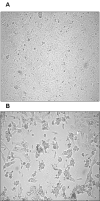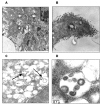Coronaviridae and SARS-associated coronavirus strain HSR1
- PMID: 15109406
- PMCID: PMC3322807
- DOI: 10.3201/eid1003.030683
Coronaviridae and SARS-associated coronavirus strain HSR1
Abstract
During the recent severe acute respiratory (SARS) outbreak, the etiologic agent was identified as a new coronavirus (CoV). We have isolated a SARS-associated CoV (SARS-CoV) strain by injecting Vero cells with a sputum specimen from an Italian patient affected by a severe pneumonia; the patient traveled from Vietnam to Italy in March 2003. Ultrastructural analysis of infected Vero cells showed the virions within cell vesicles and around the cell membrane. The full-length viral genome sequence was similar to those derived from the Hong-Kong Hotel M isolate. By using both real-time reverse transcription-polymerase chain reaction TaqMan assay and an infectivity plaque assay, we determined that approximately 360 viral genomes were required to generate a PFU. In addition, heparin (100 microg/mL) inhibited infection of Vero cells by 50%. Overall, the molecular and biologic characteristics of the strain HSR1 provide evidence that SARS-CoV forms a fourth genetic coronavirus group with distinct genomic and biologic features.
Figures




References
MeSH terms
LinkOut - more resources
Full Text Sources
Other Literature Sources
Miscellaneous
